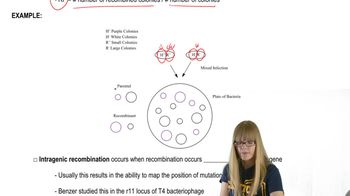The Avery, Macleod, and McCarty experiment in 1944 figured out what?
Table of contents
- 1. Introduction to Genetics51m
- 2. Mendel's Laws of Inheritance3h 37m
- 3. Extensions to Mendelian Inheritance2h 41m
- 4. Genetic Mapping and Linkage2h 28m
- 5. Genetics of Bacteria and Viruses1h 21m
- 6. Chromosomal Variation1h 48m
- 7. DNA and Chromosome Structure56m
- 8. DNA Replication1h 10m
- 9. Mitosis and Meiosis1h 34m
- 10. Transcription1h 0m
- 11. Translation58m
- 12. Gene Regulation in Prokaryotes1h 19m
- 13. Gene Regulation in Eukaryotes44m
- 14. Genetic Control of Development44m
- 15. Genomes and Genomics1h 50m
- 16. Transposable Elements47m
- 17. Mutation, Repair, and Recombination1h 6m
- 18. Molecular Genetic Tools19m
- 19. Cancer Genetics29m
- 20. Quantitative Genetics1h 26m
- 21. Population Genetics50m
- 22. Evolutionary Genetics29m
7. DNA and Chromosome Structure
DNA as the Genetic Material
Problem 1a
Textbook Question
How were scientists able to determine that DNA, and not some other molecule, serves as the genetic material in bacteria and bacteriophages?
 Verified step by step guidance
Verified step by step guidance1
Understand the historical context: Scientists initially considered proteins as the genetic material because of their complexity and diversity, while DNA was thought to be too simple.
Examine the key experiment by Avery, MacLeod, and McCarty, who used purified components from heat-killed bacteria to transform non-virulent bacteria into virulent forms, showing that DNA was responsible for transformation.
Analyze the Hershey-Chase experiment, where bacteriophages were labeled with radioactive isotopes—phosphorus-32 to label DNA and sulfur-35 to label proteins—to track which molecule entered bacterial cells during infection.
Interpret the results of the Hershey-Chase experiment: the radioactive phosphorus (DNA) was found inside the bacteria, while the radioactive sulfur (protein) remained outside, indicating DNA carries genetic information.
Conclude that these experiments collectively demonstrated that DNA, not protein or other molecules, serves as the genetic material in bacteria and bacteriophages.
 Verified video answer for a similar problem:
Verified video answer for a similar problem:This video solution was recommended by our tutors as helpful for the problem above
Video duration:
1mPlay a video:
Was this helpful?
Key Concepts
Here are the essential concepts you must grasp in order to answer the question correctly.
Hershey-Chase Experiment
This pivotal experiment used bacteriophages labeled with radioactive isotopes to distinguish DNA from protein. By tracking which molecule entered bacterial cells during infection, scientists demonstrated that DNA, not protein, carried genetic information.
Recommended video:
Guided course

Mendel's Experiments
Role of Bacteriophages in Genetic Studies
Bacteriophages are viruses that infect bacteria, making them ideal for studying genetic material transfer. Their simple structure, composed mainly of DNA and protein, allowed researchers to isolate and test the function of each component in heredity.
Recommended video:
Guided course

Mapping Bacteriophages
Chemical Composition and Function of DNA
DNA is composed of nucleotides forming a stable, information-rich molecule capable of replication and encoding genetic instructions. Its unique properties, unlike proteins, made it a strong candidate for the genetic material before experimental confirmation.
Recommended video:
Guided course

Functional Genomics

 9:32m
9:32mWatch next
Master History and Experiments with a bite sized video explanation from Kylia
Start learningRelated Videos
Related Practice
Multiple Choice
971
views
6
rank
